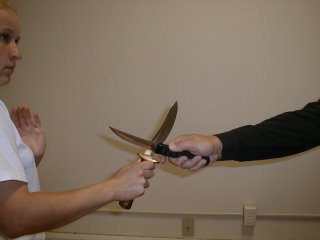
Advanced Level
Introduction
In this section, the techniques will require a more aggressive mindset and a much higher level of training than previously expected and the hazy boundary between knife defense and offense becomes even more difficult to distinguish.
Tri-Angles
Once you have become comfortable with the basics of Diagonal-Stepping, as discussed in the intermediate section, you can advance to using two diagonals to apply another concept called Triangles. Triangles are used in many martial arts such as Karate, Judo, Jujutsu, and Aikido. You will be using triangles as a method of evading and entering. This technique allows you to drive deeply into the ma-ai of the attacker, taking away his center, disrupting his energy, balance, base, and his sense of timing all in one move. Triangles are most effective when used to counter a linear technique whether a knife thrust or a straight kick and when using your middle or lower blocks. As you read through this section please refer to these simple diagrams on triangles. The triangles are created by laying out several imaginary lines.
Performed correctly, the attacker will be thrown uncontrollably backward and with great force. While performing this move there is a concern that the attacker may try to throw a punch with his left hand, which at this moment lies precariously close to the right side of your face. Be aware of this possibility and be ready to tuck your head low allowing your pushing hand and arm to block his punch.
The Octagon, Eight Angles Of Attack And Defense
The philosophy of using geometry in the fighting arts was at one time common knowledge throughout Europe. It reached perfection in the Spanish schools of rapier and dagger. The Spanish made a precise science out of what had previously been viewed as an art. Despite having said this was not a step by step book I want to describe a training concept that may help you visualize all of those inner and outer lines, triangles, ma-ai, etc. that have been discussed to this point.
Experimentation with this table and chart will reveal stepping combinations that I have missed, or may lead you to discard ones that I have given, feeling that they do not work for you. That is fine, it shows that you are thinking and training. Some of the angles may be awkward and less effective. Do not totally ignore them. Explore different ways in which they might be used to your advantage. You will not always be afforded the luxury of using the “best” line or angle.
Early Timing
Early timing is when you have practiced enough to correctly “read” the attackers intention and angle of attack. Once this is known you can move into his ma-ai, interrupting his motion while his arm or leg is still being cocked for an attack.
Never accept the full force of an attack if you can step out of reach or redirect it!
Keep in mind that early timing may be impossible in situations involving a complete surprise attack.
Late Timing
Late timing is where the attacker has made his first full thrust or slash and due to the element of surprise or fear you react by letting it pass by. This passing by is the count of one. As the knife passes you should follow it in on the “half-beat”[1] moving in to trap his arm, or otherwise restrict his movement. At the same time you should also deliver a series of blows to disarm him and terminate his attack.
Mugamae and Other Stances 
Taking the time to assume a “proper” fighting stance will create a suki (mental gap or void) that may cost you your life!
Every author or instructor seems to have a favorite fighting stance and they spend a lot of time explaining why theirs is better than every one else’s. Quite often their entire system is based around this one stance. Therefore I would be remiss if I ignored this most important element of defense. My preferred stance is called mugamae[2].
The act of taking a fighting stance openly advertises your intention to defend yourself and how you might be intending to go about it. This is not something you want your attacker to know, keep him guessing. Therefore your stance should appear as no-stance, mugamae
It is imperative that you understand the difference between a static posture and a “dead” posture. Never stand with both feet equally weighted! Think about this. The Monk’s Posture
The Monk’s Posture
This is one of my favorite stances. It is deceivingly non-confrontational, appearing to be submissive and totally passive. The monk’s posture gives your attacker a false sense of confidence. To assume the monk’s posture settle your weight into your hips and slightly flex your knees. Drop your gaze so that you are looking peripherally, out from the tops of your eyes, like looking over the top of eyeglasses. Looking this way your gaze will not be direct, and therefore not “readable,” nor threatening. Your arms should be relaxed, crossed and lightly folded on your chest.
Hittatsu no Hyoshi
Hittatsu no Hyoshi means a rhythm, or timing, of one, or just “One”. It is an
action not done to a count of one….....two, but rather, onetwo with no break in motion or rhythm. So when you are attacked you do not block and counter, you blockcounter simultaneously. Hittatsu no Hyoshi may be done empty hand, with two hands, a hand and a foot, or any number of combinations. It can also be done with a knife, either blocking empty handed and cutting in one move, or blocking and cutting with the knife while striking with a foot, a knee or the other hand. Only your co-ordination and imagination limit the possibilities.
 In training karate students I have discovered that many times there are moves
In training karate students I have discovered that many times there are moves
used as building blocks that over-complicate a technique. If you do not have years to spend learning them there are steps that can be eliminated. There should be only one move! This concept requires a mental posture of “attack” only. To make it work your attack must erupt from a state of complete focus without tension. Re-read the section on Kime. This concept is the central part of my strategy and teaching! Ironically it is also one of the smaller segments in the book. It is a concept that must be learned and cannot be taught step by step. If you practice with an open mind and work hard the multiple possibilities of Hittatsu no Hyoshi will eventually reveal themselves to you.
Targeting, Where and What, to attack?
No matter whether your philosophy, or knife practice, is reactive (you wait), or proactive (you attack), the closest and safest targets are the attacker’s extremities: hands, wrists, legs, and arms. Whenever these come into range, strike at them. Being careful to avoid traps or feints, cut at these targets while remaining outside of your attacker’s reach whenever possible. If you have a knife and you are of smaller stature or are physically weaker, it is imperative that you wear down or “worry” your attacker with a series of sniping cuts to his wrists and hands. Continue to do this until you can either discourage him, escape from the area, or take advantage of a gap in his defenses to terminate the conflict.
William Fairbairn’s WW-II manual “Get Tough” contains this chart (42) that outlines vascular system illustrates our primary targets. Keep in mind that the cuts described in this chart are intended for killing enemy combatants. Severing any of these can cause unconsciousness and death in under a minute.
Technique #2: against a high thrust to your right, using the defensive posture.
When the attacker thrusts to the right side of your blade, react to his attack by driving your knife straight forward from where it lies by your right hip in a high thrust, mirroring your attacker’s move. The point of your knife should initially be aimed toward his right shoulder, your knife angled across your body. Stepping out to your left front with your left foot, your body should lean to the left. As your thrust is extended the tip of your knife will end up aimed straight for the attacker’s eyes.
[1] A “Half beat” is when you move on a count between one and two, taking control of the rhythm from the attacker.
[2] Mugamae can be translated as, “the stance of no stance”.



0 Comments:
Post a Comment
<< Home